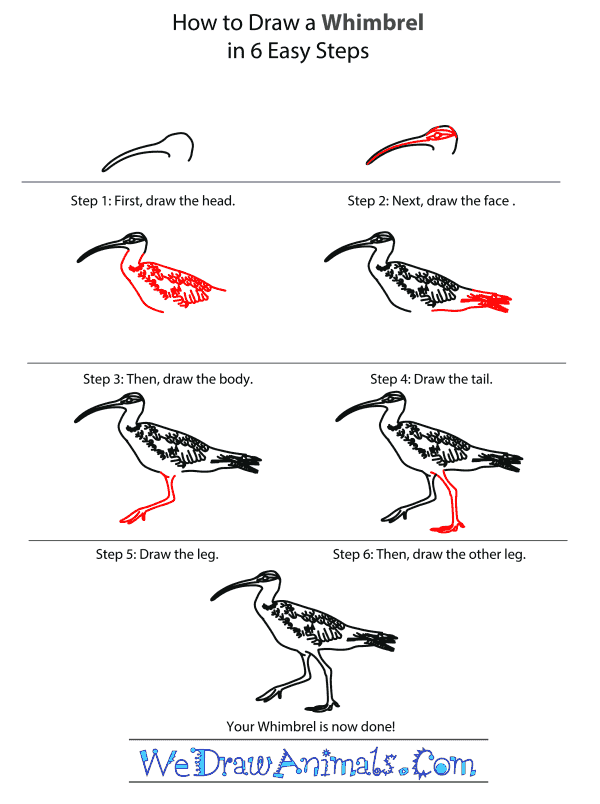In this quick tutorial you'll learn how to draw a Whimbrel in 6 easy steps - great for kids and novice artists.
The images above represent how your finished drawing is going to look and the steps involved.
Below are the individual steps - you can click on each one for a High Resolution printable PDF version.
At the bottom you can read some interesting facts about the Whimbrel.
Make sure you also check out any of the hundreds of drawing tutorials grouped by category.
How to Draw a Whimbrel - Step-by-Step Tutorial
Step 1: The whimbrel is one of the most wide-ranging shorebirds and are found on most continents, even the arctic! To draw this world-traveling bird, make a circle for the head with the bottom open, and a long, narrow, and slightly curved beak. It uses this beak to find food buried in the sandy shores of its home.
Step 2: Next, draw the face. Add a line dividing the beak in half. Add an eye and the eye markings.
Step 3: Starting with the neck, draw the body. The line for the back is mostly straight, and the front curves at the neck, is straight at the chest, and then curves back in for the leg area. Add some feather details.
Step 4: Now draw the tail. It looks a bit like a sideways M at the tip, doesn't it?
Step 5: Draw the front leg of your bird. Bend it a little less than halfway down. Its legs are long so it can stand in shallow water and not get wet!
Step 6: Then draw the back leg. You can make the lines here mostly straight. Your whimbrel is now done! To color your picture, the whimbrel is greyish brown and has a white belly with grey-brown spots. The tail and head are dark brown, and it has a black beak.
Interesting Facts about the Whimbrel
One of the longest ranging shore birds on earth the Whimbrel has breeding grounds in the Arctic as well as the Eastern and Western hemispheres. They migrate South America, Australia, South Asia, and Africa which makes their range so impressive. They are easy to identify with their long curved bills that they use to search along muddy shorelines for food like bugs, grubs, and small crabs. Whimbrel’s are often seen eating in groups during low tide.
Did you know?
- Whimbrel’s build their nests on the ground scraping a hole and filling it with moss, lichen, or grass.
- That Whimbrel’s nest in colonies of several hundred pairs but are still territorial and fight to protect their nests.
- Young Whimbrel’s are able to feed themselves shortly after hatching and can fly by 4 weeks old.
- The curve of the Whimbrel’s bill matches the burrows of fiddler crabs,
- Whimbrel’s will often clean the mud and debris off of their food before eating it
Lesson plan note: :Whimbrel’s depend on their curved bills to catch food. Take a large curved tube and place an object like a ball at the base. Then have students shape their fingers into a bird beak and reach down the tube to try grabbing the ball to feel what it’s like to be a Whimbrel.







